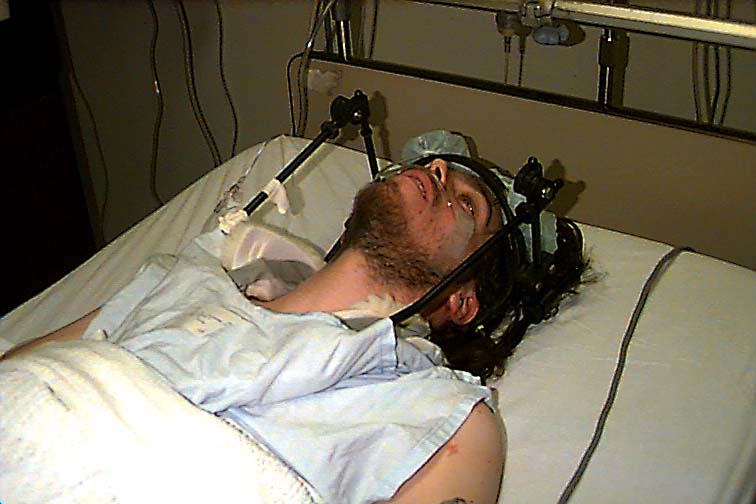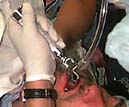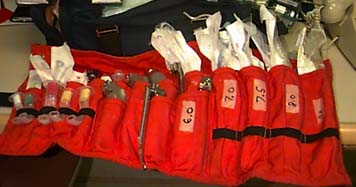 Go to Front Page
Go to Front Page
 Go to Scenarios
Go to Scenarios
 Go
to Techniques
Go
to Techniques
Emergency Intubation
The contents list on the front page can be
used to find areas of interest. Move around by clicking on any text or picture
highlighted in blue or purple. As you read any section if you notice a topic
about which you want to read more then just click on it to be transported
there. If you want to return to the previous page after reading any section
then press the back button on your browser. We recommend Netscape as an
ideal browser for this document. The main sections are on scenarios
encoutered and how to deal with them, techniques
you can use, dilemmas in management, drugs,
and there is a pretty nifty demonstration of how to do a cricothyroidotomy
with illustrations.
Disclaimer etc
The methods and treatments options described in this document reflect the
authors opinions and are not the sole way of approaching these problems.
Every effort has been made to check on accuracy of doses etc but readers
should use this advice in conjunction with other recommendations in the
literature. Readers should exercise their own judgement in dealing with
the situations they encounter.
All patients whose photographs appear in this document have given consent
for such use.
Introduction
Intubation in an emergency situation. Outside the operating room suite can
be a very demanding experience for the trainee anesthesiologist. It is often
the first time when the resident's anesthetic skills are tested to the limit.
The anesthesiology resident is usually without the direct supervision of
an attending anesthesiologist and there may be no time for consultation.
All the anesthesiologist's skills are rapidly brought into play.
A complex and often deteriorating situation must be assessed and a focused
evaluation of the patient must be made. There is no cookbook single technique
for intubation in these circumstances. The situations encountered may vary
widely and an appropriate method of intubation has to be chosen. There is
potential for development of airway loss and serious harm occuring to the
patient.
The patient is often critically ill and assessment and intervention has
to be rapid. Attempts at intubation may already have been made by less experienced
physicians from other specialities. Intubation may be difficult or impossible
and a change alternative method may be called for after one tecnique is
started. All these factors make emergency intubation outside the OR an extremely
challenging situation.
This document is designed to be an introducion to how to manage emergency
intubation, it describes the scenarios which may encountered and suggests
techniques which may be useful in different situations.
Successful application of a residen'ts training in airway management in
these difficult scenarios is very rewarding. But don't expect any particular
thanks, you are just doing your job.
What to do when called to an Emergency Intubation
Immediately answer the page. If it is a code situation, the airway management
team needs to grab the necessary equipment and go. However, if it is an
elective intubation, they can call to determine the urgency and to get a
preliminary assessment of the situation.
 The Code box
The Code box
It also helps to grab another "set of hands" to help with the
intubation. This may be a more experienced person or just another person
to help, i.e. hold cricoid,
push medication, etc.
What to do upon arrival
The clinician should announce his/her arrival and determine who is in charge.
Determine if the patient is oxygenating. This is where the other set of
hands helps; They can assess the airway and assist ventilation if needed,
while the clinician gets everything ready.
After a quick discussion with whomever is in charge and by using their clinical
skills, the person intubating should determine the urgency of the situation.
Don't forget that the situation may change while you are assessing the patient,
what was an elective urgent situation may deteriorate into an emergent situation.
Find out why they need to be intubated.
This should all be done as quickly as possible.
If it is determined that the patient is oxygenating (either on their own
or with assistance), there is time for obtaining a brief, pertinent history.
Brief, Pertinent History
Reason for admission
PMH - especially CNS, CVS, Respiratory, Airway
PSH - Have they ever been intubated?
Medication and allergies
Physical Exam
A. Vital Signs/Hydration
B. Airway
C. Cervical Spine
D. Recall PMH and reason for admission or deterioration and look for pertinent
subtle signs.
What to do now?
Ask - Am I the appropriate person for this or do I need a more experienced
person?
Develop a plan and a back-up plan.
The difficult airway algorithm comes in handy here.
Remember the capacity to do harm exists.
Remember there are differences from the OR.
A. Equipment: no machine, unfamiliar locations or unavailability of vital
equipment.
B. Monitoring: Manual BP, +/- EKG, +/- Pulse ox
C. Personnel: Often no skilled assistance available, unfamiliar with airway
management, backup anesthesiologist not immediately available.
D. Patient: Not optimized-hypoxemic, hemodynamically
unstable, uncooperative,
altered airway (tracheostomy, edema,
soft tissue swelling, hemorrhage, OGT/NGT, surgical), positioning, access
limitation. Also, widely variable presentation-from full cardiovascular
or respiratory arrest to fully conscious and aware, unstable
C-spine/external fixation.
Have all equipment ready
Suction
Ambu bag with 100% oxygen (always preoxygenate)
Airways (nasal and oral)
Bougie
Laryngoscopes and blades
Tubes/stylets/syringes
Running IV
LMA
Cricothyrotomy kit
 Airway equipment
Airway equipment
Also, have anything pertinent to your plan and back-up plan; appropriate
medications and equipment available in the event of inability
to mask ventilate/intubate.
 Go to Front Page
Go to Front Page
 Go to Scenarios
Go to Scenarios
 Go
to Techniques
Go
to Techniques